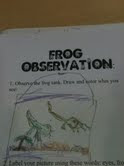Here's an interesting "statistical" look at Candy Land (complete with "recommendations made for preserving the sanity of parents who must participate in the games").
http://www.namics.nysaes.cornell.edu/news15/cootie.html
Yes, I truly loathe Candy Land; but it does serve a valuable purpose. As a teacher, I appreciate the pre-math skills of matching and sequencing. More importantly, there are the social aspects of turn taking, following an agreed upon set of rules, and winning and losing with grace. Which is why I suffered through untold hours of trip trapping up the colorful path to Dora's rainbow colored fiesta.
Mercifully, my children are both out of the Candy Land stage, but we still play games at my house. Believe it or not, we don't have a video game system; we're strictly old-school. Once a week, we geek out on a board games or card games. My little Candy Land girl has moved on to Chess, Monopoly, and Quirkle. My son is now obsessed with the game Risk. My husband and I have an ongoing Scrabble showdown (the poor fellow still can't accept the fact that I win EVERY TIME).
You may be aware that I have carried my love of games over into the classroom. I dream of one day writing an entire elementary school curriculum based on game playing.
Why?
First, there are the obvious academic benefits. Given a choice flashcards or a fun card game to work on addition skills, most kids would pick the game. Games help children detect patterns, predict outcomes, plan ahead. Kids quickly learn about strategy and luck.
Games strengthen skills in
addition, subtraction, multiplication (Shut The Box, Yahtzee, War, Sorry, Trouble),
logic, deduction (chess, Mancala, Mastermind, Clue, Othello, Quirkle, Guess Who?, Battleship),
money (Monopoly),
reading and language (What's Gnu?, Scrabble, Boggle).
More importantly, there is the social development:
Collaboration
Competition
Following rules
Reasoning
Sharing
Turn taking
Honesty
Learning from experience
Taking risks
Understanding that sometimes your luck can change in an instant.
Understanding that you might not always win, but if you quit you will never win.
Learning to lose and win with grace.
Though board games have fairly rigid boundaries, I like to allow for creativity and flexibility. Don't like a particular rule? Come up with a new one. Just make sure it is agreed upon before play begins.
Want to make family game night a part of your routine? I've got many, many games that I can recommend. I'd also be happy to send specific games home with your child if you would like to take a test drive before purchasing.
Look at our little tadpoles! Well, not quite tadpoles, not quite froglets...tadpolets? Frogpoles? They've grown hind legs, and one little fella is starting to sprout some front legs, too.
Here are some of the kids' science logs ("Frogservations"?) from this week:
The students in our neighboring class were kind enough to let us borrow their teacher, Ms. Heidi, yesterday afternoon for some special yoga time. Look at these relaaaaxed bodies and minds. We hope to make this a regular occurrence!
Mid-year conferences will be on Friday December 7th
Here's our schedule. If you need to switch, contact the family with the time slot you'd prefer. Let me know about any changes.
9:00-Oliver
10:00-Annabella
11:00-Bo
1:00-Aidan
2:00-Jakob
3:00-Tani
4:00-Paul
































































